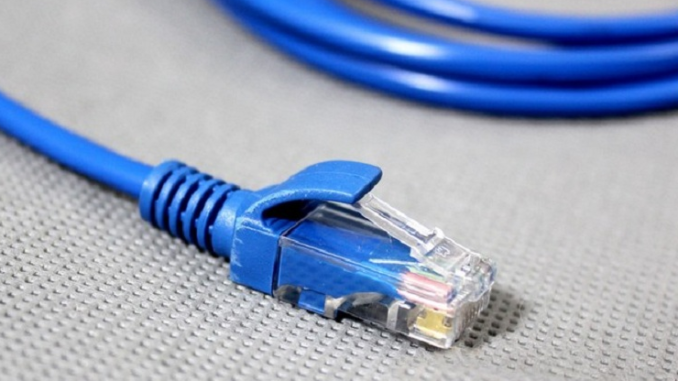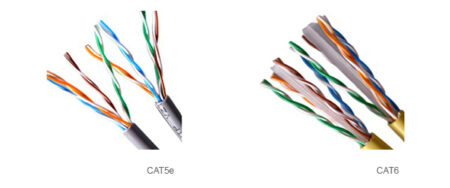
Ethernet cables are constantly being upgraded to increase bandwidth speeds and reduce noise. Therefore, you may be wondering which cable to choose. In this article, I will explain the difference between CAT5e and CAT6 in an easy-to-understand manner. Help us make informed decisions and choose the best solution for your application.
What is a CAT5e cable?
CAT5e is a network cable standard established in 1999 and is also called “Category 5e” or “Category 5 Enhanced”. CAT5e is a significant improvement over traditional CAT5 standards. It is up to 10 times faster and has a significantly improved ability to transmit long distances without being affected by crosstalk. CAT5e cables are typically twisted pair cables with a thickness of AWG24 and can support Gigabit networks with segment distances up to 100 m.
What is a CAT6 cable?
Derived from “Category 6,” CAT6 appeared just a few years after CAT5e was developed. CAT6 is a standardized twisted pair cable for Ethernet that is backward compatible with the CAT5 / 5e and CAT3 cable standards.
Like CAT5e, CAT6 cables support Gigabit Ethernet segments up to 100m, but can also be used for 10 Gigabit networks over short distances. Earlier this century, it was common to use CAT5e for wiring to workstations and CAT6 for the backbone infrastructure between routers and switches.
Bandwidth Differences Between CAT5e and CAT6 Cable
Both CAT5e and CAT6 support speeds up to 1000Mbps (1Gbps). This is more than enough for most internet speeds. This is because it is unlikely that you will have a maximum of 500 Mbps in your current Internet connection.
The main difference between CAT5e and CAT6 cables is the bandwidth supported during data transmission. CAT5e cables are designed for operating frequencies up to 100MHz, while CAT6 cables are designed for operating frequencies up to 250MHz. This means that CAT6 cables can handle more data at the same time. It’s easy to compare the difference between a two-lane highway and a four-lane highway. Both highways run at the same speed, but four lanes allow more cars to pass at the same time.
The difference in speed between CAT5e and CAT6 Cable
CAT6 cables operate at speeds up to 250MHz, which is more than double that of CAT5e cables (100MHz), and support speeds up to 10GBASE-T (10 Gigabit Ethernet). In contrast, CAT5e cables support up to 1GBASE-T (1 Gigabit Ethernet).
Differences between CAT5e and CAT6 crosstalk
Both CAT5e and CAT6 are twisted pair cables. Both use copper wire and typically use 4 twisted pairs (8 wires) per wire. Traditionally, CAT6 250MHz performance has been achieved by inserting nylon splines inside the cable to separate the four twisted pairs from each other, increasing the stiffness of the cable. Today, CAT6 cables are evolving softer by using other noise reduction methods.
Whether you use splines or not, CAT6 has more stringent specifications for crosstalk and system noise. Compared to CAT5e, CAT6 significantly reduces transmission interference, or near-end crosstalk ( NEXT ), and also improves equal-level far-end crosstalk ( ELFEXT ), return loss (RL), and insertion loss (IL). .. As a result, system noise is reduced, errors are reduced, and data transmission rates are higher.
The difference in maximum transmission distance between CAT5e and CAT6 Cable
Both CAT5e and CAT6 support distances up to 100m per network segment. The maximum speed cannot be achieved over longer distances. It may slow down, the connection may become unstable, or the connection itself may be impossible. Repeaters and switches must amplify the signal to transmit distances in excess of 100 m.
When used for 10GBASE-T, the maximum transmission distance of CAT6 cables is limited to 55m. Beyond this distance, the rate drops to 1GBASE-T. We recommend using CAT6A (Augmented Category 6) cable for 10GBASE-T transmission over distances over 100m.
Differences in appearance between CAT5e and CAT6 Cable
In most cases, the cable has the cable category printed on it. Otherwise, you won’t be able to distinguish the cables by color or RJ45 connector. However, CAT6 cables often use thicker copper wire, which makes them thicker than CAT5e cables.

The cost difference between CAT5e and CAT6 Cable
There are several characteristics that affect the cost of an Ethernet cable, but the main factors are length, quality, copper content, and manufacturer. Generally, CAT6 cables are priced 10 to 20% more expensive than CAT5e cables.
Conclusion
There are many things to consider when choosing the best cable. What about network speeds-100Mbps, 1000Mbps, 10Gbps? What about the number of users? If you have a large number of users, the frequency of the cable (MHz) is important. Is the cable used indoors or outdoors? Which is better, a hard cable or a soft cable? Is there anything that could be an interference factor? Ultimately, cable selection becomes an application issue.
We often hear that it’s a waste to invest in high-performance cables (such as CAT6) because current network infrastructure hardware doesn’t require 10Gbps speeds. However, the hardware will be upgraded over time. It’s much easier to upgrade your hardware than to lay a new cable. The price difference between CAT5e and CAT6 cables is not that great, so it’s usually a good idea to choose a higher quality cable. That way, you can build a network infrastructure that can demonstrate high performance in the near future.
However, whether it’s CAT5e or CAT6, the most important thing is to choose a 100% copper quality cable. Data show that poor wiring systems account for up to 70% of network downtime (only 5% at initial network investment). You don’t want to invest in a wiring system that doesn’t guarantee performance because you focus too much on cost savings. Make sure you buy it from a supplier that offers a lifetime warranty on individually ETL certified CAT5e and CAT6 cables.
Original Article Source from https://www.blackbox.co.jp